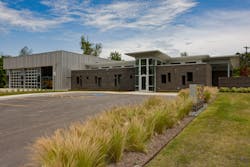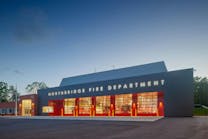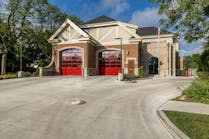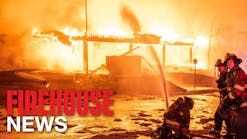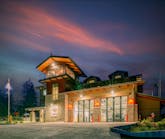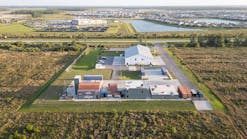Station Design: When Prototype Fire Station Design Does and Doesn’t Work
If your department is in a high-growth area or in need of replacing numerous fire stations, one approach to developing multiple fire stations is using a prototype fire station design process. Often, this approach comes with the assumption that there will be savings in design costs, design durations and, ultimately, construction costs that are based on the implementation of multiple projects at one time. The benefits can extend into operational flexibility and a savings in facilities maintenance. All of this can be true—or not—depending on how a prototype is developed and implemented.
Job 1: Not savings
The most basic use of a prototype approach comes with the least design savings but the most design and operational flexibility. This approach often starts at the programmatic level through the design of fire station concept floor plans, which are then site-adapted at each location. For large metropolitan station replacement or relocation programs, this might include a variety of concept plans that are based on operational needs and the number of assigned companies. This prototype often would be developed with a list of interior finishes and mechanical and electrical design summaries. It also would include specifications to be used to standardize specialty equipment (such as vehicle exhaust systems for the apparatus bay) and materials (such as the use of masonry walls for certain rooms). The exterior design of each station is developed from the concept plan and adapted to each site and neighborhood context. This limited use of the prototype approach provides operational consistency and standardization of equipment and materials, which can improve operational flexibility and reduce facility maintenance costs in the future. It provides a roadmap to move forward, but it doesn’t result in a savings in design fees and delivers little savings in design time: Each station is a new design that’s based on a set of standards and floor plans.One adaptable design
At the other end of the spectrum—and what most departments view as a prototype design process—is the development of a single fire station design, from plan layout to completed exterior design, which can be site-adapted with minimal design changes. A single exterior design concept would be implemented at each location with perhaps color or minor exterior material changes to conform to the neighborhood context.
To optimize the savings in this approach, each site must be selected specifically to support the floor plan and site requirements for parking and turning radii. This approach is best used when a department is seeing its response boundary expand or shift and needs to add single- or two-company stations to meet this demand. This approach currently is being implemented in the northwest Arkansas communities of Springdale and Fayetteville. Both communities have seen rapid suburban expansion and the subsequent need to add multiple fire stations to meet their expanded town boundary response times.
For each of these departments, a strong foundation was developed via a response study, an operational-needs assessment and a space-needs outline. These documents defined the operational goals, the site criteria and location and the approximate square footage of the prototypical plan. The operational goals were focused on future flexibility. For instance, in Fayetteville, the apparatus bays and site are required to accommodate the largest apparatus for future staging or to use as reserve storage. The living areas are planned to support a single engine company, with space to accommodate a second two-person company in the future. The floor plan arrangement for this prototype is extremely compact, so it could be placed on a narrow site. (The suitability of a narrow site provides more flexibility in locating each station.)
The Springdale Fire Department, having successfully completed the construction of three versions of their prototype station, is in the process of building two more—the construction for one being about 65 percent complete, the other having gone out to bid. Lessons learned include:
Pros
- After a needs assessment was completed by the architect and the construction manager, it was determined that the space-needs outline produced a building program that met all of the department needs. The construction manager in this case developed the cost budget, and the size of the station was adjusted in the program phase to meet the cost goals.
- The site and station design easily were adaptable to different topography, with few changes to the overall design concept
- As each subsequent station is built, the construction manager and the architect continue to search for better ways to accomplish the goal on each station. The station that’s constructed last should be the most cost-effective, most efficient station among the five that will be built.
- Given that crews lived in two of the stations prior to beginning the construction of the other three stations, lessons were learned and changes that crews suggested were incorporated into the building of the final three stations.
- A floor plan that the department embraced as operationally efficient and comfortable gained support from the crews for additional stations to be the same. Most comment that the stations are much nicer than they anticipated.
- There are economies of scale due to replication. This also makes the building inspection process easier, because the inspectors know where the so-called trip hazards exist, which lessens time for inspection.
Cons
- The placement of the stations tried to plan for the future, but with changes in new construction in expanding suburban areas, the stations might not be best located for future response time improvement after all.
- Securing the same subcontractors for each additional station is beneficial. However, if the same subcontractors can’t be secured, it’s vital that the construction manager carries forward everything that was learned from building the first stations.
- Although a prototype can allow for multiple companies and services to be housed, it might limit the ability for modifications.
- It takes additional time to go through the process of considering a prototype; a clear organizational vision is required and backing from elected officials that support that vision must be obtained.
- An important part of the design aesthetics of the Springdale prototype is glass, including for the natural lighting that it provides. Designs that incorporate a lot of glass can prompt resistance from construction crews.
Possibilities
Prototype fire station design can be an effective design and development tool for any department that’s seeing significant growth or population changes and needs new fire stations. The process begins with a solid, departmentwide operational plan to establish response-company needs and station locations. If used on the basic level to establish a prototypical floor plan and building-performance criteria or, at the other spectrum, for a complete design that’s built multiple times, the prototype station design process can be an efficient means for station development. It also can aid in meeting future response demands while minimizing maintenance costs through standardization.
Mary McGrath
Mary McGrath’s 25 years of experience includes all phases of professional design services, from the crucial first step of community and stakeholder participation, through building design and construction administration. She has had full responsibility as principal-in-charge for a variety of community-serving projects and has refined her operations-based design approach to develop master plans and facility programs.

